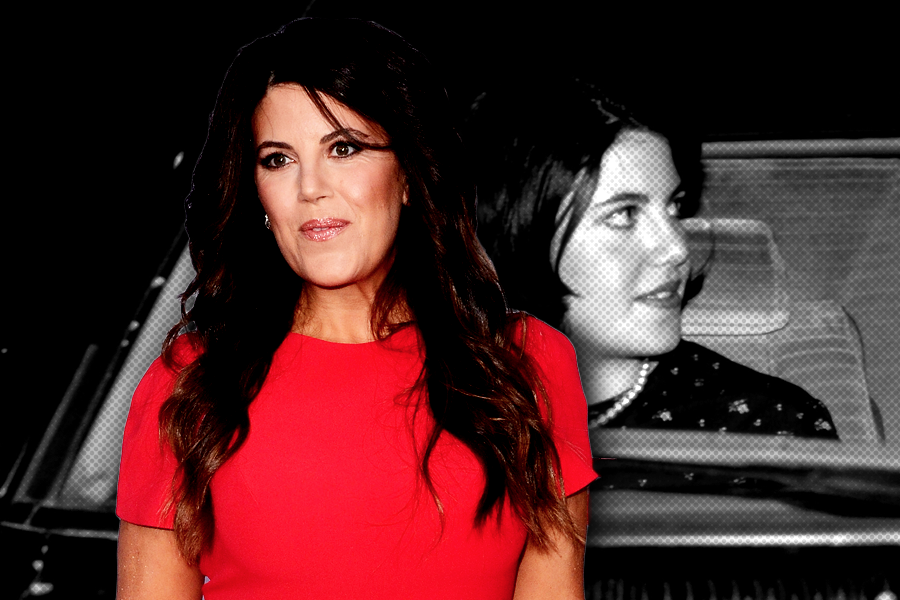At age 44, Monica Lewinsky’s reinterpretation of the Clinton scandal of her twenties hints at the classic midlife act of taking stock of your life.
Psychologists don’t agree on whether a midlife crisis actually exists. But the trope does, the one where men are sleeper cells genetically activated on their 40th birthdays to purchase a sports car, pierce one ear, and sleep with a tennis instructor. Still, enough people — men and women — self-report feeling restless and dissatisfied enough in middle age to rethink everything that it can’t be completely dismissed out of hand. All we know is that anyone can be miserable at any age and do embarrassing stuff, but for a lot of people, it hits somewhere between age 30 and 50.
Take Monica Lewinsky’s latest piece in Vanity Fair, which offers a fascinating reexamining of her affair as a 22-year-old with Bill Clinton. “Now, at 44, I’m beginning (just beginning) to consider the implications of the power differentials that were so vast between a president and a White House intern,” she writes. “I’m beginning to entertain the notion that in such a circumstance the idea of consent might well be rendered moot.”
Of course, more happened in the last two decades than just getting older. Much of Lewinsky’s new understanding of the affair coincides with the #MeToo movement’s radical disclosure of past assaults and harassments women face everyday. Lewinsky credits the movement’s general support and lending of credibility to previously silenced voices with giving her the courage to reexamine her own past in a public way.
But she also got older. New Yorker critic Emily Nussbaum noted that such reexaminations are a common for women over 40, tweeting that “it’s hard to see certain experiences for what they are until decades later.”
Got a lot out of the Lewinsky essay & was so struck by a phenomenon that goes way past her situation: so many women are currently reinterpreting experiences from their teens/twenties when they're 40+. It's hard to see certain experiences for what they are until decades later.
— Gremliny Nussboo (@emilynussbaum) February 26, 2018
That’s true for a lot of experiences. Lewinsky’s language could be the words of any midlife person, male or female, realizing the past suddenly looks much different with the sheen of age, experience, hindsight, and a newfound sense of mortality slapped on it. “What it means to confront a long-held belief (one clung to like a life raft in the middle of the ocean) is to challenge your own perceptions and allow the pentimento painting that is hidden beneath the surface to emerge and be seen in the light of a new day,” Lewinsky writes.
That long-held belief could be the very anchoring of your personal relationships with friends, family or coworkers. It could be career ambitions that didn’t quite take the shape you imagined. It could be understanding the impact of your childhood on your current relationships, and the nagging sense that, somehow, your steps were laid out for you. It could be the city you live in, the house you call home, the person you slept next to all those years, the gender or sexual orientation you claimed as yours.
Lots of people report that somewhere between 30 and 50, shit gets real. Andrew Oswald, an economist at the University of Warwick who co-authored a paper on the issue that surveyed 1.3 million people in 51 countries, claims to have charted a distinct U-shaped curve of life dissatisfaction that dips during precisely these decades for all sorts of people from all walks of life. “There is definitely a midlife low,” he told Claire Suddath at Bloomberg last year of the data points.
But when Suddath ran this seeming slam-dunk confirming the midlife crisis by psychology professor Susan Krauss Whitbourne at the University of Massachusetts-Amherst, Whitbourne scoffed. “I’ve been doing research for pretty much my whole career on adult development, and I’ve never found age linked definitively to anything psychological about a person,” Whitbourne told her. “You can call it a midlife crisis. A quarter-life crisis. But whatever’s going on with you personally, you can’t blame it on age.”
But that doesn’t mean there aren’t certain life events more likely to happen during this age span that could increase the odds of unhappiness, or at the very least trigger a reexamining that feels disorienting. Suddath argues that the so-called midlife crisis we perpetuate could just be a side effect of contemporary adulthood, but even so, midlife happens to be the age where the intersections feel like they’ve nailed you.
These are our “prime working years,” for starters — and one study she notes found that people who most hate their jobs are between 30 and 55. This age range is also when most of us feel firmly locked into our lives in general — or what you might call “stuck” — particularly if we are married, have kids and are responsible for knocking out a mortgage every month.
Other factors: The average length of a marriage that ends in divorce is 8 years. The average man marries at age 29. You do the math: Divorce is lining right up with approaching 40. (And real midlife would begin in the thirties, anyway, given that the average lifespan for men is 76.) This is also when people are rearing children, and early childhood rearing is among the lower satisfaction points for parents.
Middle age is also typically when many people first start experiencing illnesses that can cut lives short, or the lives of their parents. Bodies change and don’t bounce back as well from bad diets, too many drinks, or minor injuries anymore. People start to finally feel their age. The “middle-aged spread” is, unfortunately, not referring to your ability to do the splits; it’s the fact that you add one to two pounds a year to the middle between 35 and 55, in part because men start losing testosterone at this age, too.
Or, the so-called crisis could just be the panic that comes from realizing that, at midlife, you’re now what Jesse Bering refers to over at Scientific American as “half dead.” Meaning, you’re not exactly old yet, but you’re definitely no longer young, and there’s no going back. Hope you made good choices!
“I’ve long feared the day when I, too, might inherit this shameful affliction, struck down by a sudden, incurable case of Joe-Shmoe hedonism,” Bering writes. “The most frequent symptoms of this disease, I gathered from television, were a shiny new convertible (or prize-winning stallion), a toupée, and the unshakable delusion that one is now attractive to twenty-year-old co-eds.”
But this is where psychology prof Whitborne’s skepticism is helpful. “People do go through periods of self-evaluation, but it’s not tied to age,” she told Bloomberg. “If someone close to you dies and you start to think about how life is limited, is that a mid-life crisis? Or is it just a healthy reevaluation of your priorities?”
Margie Lachman, director of the Lifespan Developmental Psychology Laboratory at Brandeis University, told The Guardian that we should think of it as not a crisis, but a “turning point or midpoint check-up. The middle of life is a natural time for reflection on one’s life: How is it going? Is this all there is? Do I want to make changes?” They cite research that found that while women are slightly more likely than men to describe their middle age as a crisis, for them, it’s more tied to physical changes, whereas for men, it’s more tied to career. In one survey from the National Institute of Changing, only a third of Americans said they’d actually had a midlife crisis.
Maybe it’s best, then, to think about hitting midlife as the New Year’s Eve of aging. It’s an appointment you can’t refuse — the clock is counting down, and come midnight you will have to kiss someone, and nothing will make you more keenly aware of whether you’re with the right person than this moment. The person can be a literal person, or a career, or an artistic or fitness goal, a travel destination, a savings account, or an entirely new life. It’s like Monica Lewinsky realizing that what she thought was the agency to choose a bad affair was just the illusion of control; it could be realizing you’ve never been cut out to sell insurance.
Whatever you don’t like might be fixed; whatever you didn’t do, maybe there’s still plenty of time left to do it, or maybe you realize you don’t want to do it as badly as you thought. For most of us, the good news is that won’t look anything like a crisis, but more like a regular life.

